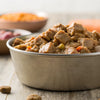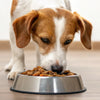Can You Mix Dry Dog Food with Wet Dog Food? A Comprehensive Guide for Pet Owners
- Houndsy
Table of Contents
- Introduction
- The Case for Mixing Dry and Wet Dog Food
- Potential Drawbacks of Mixing Dry and Wet Dog Food
- How to Mix Dry Dog Food with Wet Dog Food
- Tips for Successful Mixing
- Conclusion
Introduction
Have you ever watched your dog sniff cautiously at their food bowl, only to turn away in disinterest? According to recent surveys, approximately 50% of pet owners contend with picky eaters, which can turn mealtime into a daily battle. This frustrating experience isn’t unique, and it raises an essential question: Can you mix dry dog food with wet dog food?
At Houndsy, we understand the importance of providing your furry friend with a balanced, appetizing meal that meets their nutritional needs while fostering a positive eating experience. This article aims to delve into the nuances of blending dry and wet dog food, offering valuable insights for pet owners looking to enhance their dogs' mealtime joy.
Throughout this blog post, we will explore the benefits and potential drawbacks of mixing these food types, suitable ratios for incorporation, and practical tips for implementation. By the end, you’ll have a clearer understanding of how combining dry and wet dog food can not only cater to your dog’s dietary preferences but also promote their overall health and wellbeing.
So, let’s embark on this journey to improve our pets’ mealtime together.
The Case for Mixing Dry and Wet Dog Food
1. Nutritional Balance and Variety
The foundation of a well-rounded diet for dogs often includes both dry and wet food. While dry kibble offers ample nutrients and lower moisture content (about 10% water), wet food is typically rich in water (often 75-78%) and essential nutrients that can complement your dog's diet:
-
Hydration: Wet food can significantly assist in hydrating your dog, particularly important for dogs that don’t drink enough water, those with urinary issues, or older dogs who may need additional fluids.
-
Palatability: The inviting aroma and texture of wet food can entice even the most discerning eaters. Mixing dry food with wet can transform a mundane meal into an appealing feast, encouraging your pup to finish every last bite.
-
Increased Nutrient Intake: Canned or pouched wet food often contains higher-quality protein sources that may appeal to pet owners looking to offer their dogs premium nutrition.
2. Cost-Effectiveness
Mixing dry and wet food can be a savvy financial decision. By incorporating wet food into dry kibble, you can:
-
Cut Costs: Instead of serving entirely wet food—which is generally more expensive—using a combination may help manage your budget while still offering your dog a flavorful meal.
-
Reduce Waste: This approach limits the waste that can occur when only wet food is offered, given its shelf life and the need for timely consumption. Dry food lasts longer and requires less careful handling.
3. Medical Benefits
Feeding a combination of dry and wet food might be particularly beneficial for:
-
Senior Dogs: As dogs age, their sense of smell may diminish, and they may find it more challenging to chew. Adding a moisture-rich wet food can ease digestion and provide a more appetizing option.
-
Dogs with Dental Problems: For dogs struggling with dental health, wet food can provide a softer texture that’s easier to consume.
-
Weight Management: The high water content in wet food can create a feeling of fullness without adding excessive calories, which is beneficial for overweight dogs.
4. Texture and Experience
Utilizing a combination of dry and wet food offers sensory stimulation to your pet during meals:
-
Engaged Eating: Mixing the crunchy texture of dry kibble with the softness of wet food provides dogs with an enjoyable eating experience, appealing to their instinctual eating habits.
-
Novelty: Dogs enjoy variety in their meals just as much as we do; mixing different food types can make mealtime feel less repetitive.
Potential Drawbacks of Mixing Dry and Wet Dog Food
While there are many advantages to combining wet and dry dog food, it’s essential to acknowledge the possible downsides as well:
1. Increased Cost
Although mixing can reduce the overall expense compared to a wholly wet diet, it is still more costly than relying on dry kibble alone. Carefully budget for two types of food, especially if you’re using high-quality options.
2. Storage Considerations
Proper storage for both food types is crucial:
-
Shelf Life: Once opened, wet food typically has a shorter shelf life than dry kibble and should be refrigerated and consumed within a few days to maintain freshness.
-
Perishability: Mixing creates food that must be consumed within a certain timeframe. Leaving combined food out can lead to spoilage and bacterial growth, which can be harmful to pets.
3. Nutritional Imbalance Risks
Mixing these two types of food can inadvertently lead to nutritional imbalances if not carefully calculated. For instance:
-
Excessive Calories: Feeding too much of both may lead to weight gain if not portioned correctly. It’s crucial to measure food and calculate appropriate servings, considering your dog’s size and activity level.
-
Diet-Specific Needs: Dogs with specific dietary restrictions (such as allergies) should only consume food that adheres to their prescribed diet. Mixing different brands or types can lead to unwanted health changes.
How to Mix Dry Dog Food with Wet Dog Food
-
Determine the Right Ratio: A standard guideline suggests that for most dogs, about 75% of the meal should be dry food, while 25% can be wet food. This can be adjusted based on your dog's specific needs, activity level, and health concerns. Consulting your veterinarian for tailored advice is recommended.
-
Transition Slowly: Making sudden changes to your dog’s diet can lead to digestive upset. Introduce the new combination gradually over a week, incrementally increasing the portion of wet food to allow their system to adjust.
-
Monitor Specific Needs: Regularly assess your dog's health and body condition, especially for senior dogs or dogs with special needs.
-
Avoid Leaving Mixes Out: Serve the mixed food in appropriate portions, and discard any leftovers after 20-30 minutes to avoid spoilage. Clean feeding bowls after meals to maintain hygiene.
-
Watch for Reactions: When changing diets, keep an eye out for any adverse reactions such as gastrointestinal upset. If your dog shows signs of discomfort, consult your veterinarian.
Tips for Successful Mixing
-
Collaborate With Your Vet: Always consult a veterinarian before changing your dog's diet to consider health concerns related to specific dietary needs.
-
Balance Texture and Flavor: Experiment with different brands and flavors to discover the mix that your dog enjoys most. Imagine your day where you’re excited about dinner; that’s how we want our dogs to feel too!
-
Utilize Quality Ingredients: Look for high-quality wet and dry food options that offer balanced nutrition. Products that boast natural ingredients, like our Houndsy Kibble Dispenser, guarantee freshness and quality—vital for your dog’s wellbeing.
-
Maintain a Schedule: Establishing a feeding routine helps regulate your dog's digestion and sets consistency around mealtimes.
Conclusion
Combining dry and wet dog food can be a game-changer not just for the palatability of your pet's meals but also for their overall health. By enhancing hydration, nutritional variety, and enriching their dining experience, we can transform mealtime into a joyful ritual instead of a chore.
Your dog deserves every opportunity for a satisfying, nutritionally balanced meal. As you set out to mix their food, don’t forget to consider our flagship product: the Houndsy Kibble Dispenser. This innovative option ensures perfect portion control, which can simplify the process of feeding our pets.
Let’s be committed to enhancing our pets’ everyday experiences while sharing joyful moments around the bowl. Are you ready to mix it up for your best friend?
FAQ
Can I mix dry dog food with wet dog food safely?
Yes, mixing dry and wet dog food is safe and can provide nutritional benefits while enticing picky eaters. Just ensure to transition slowly and monitor for any adverse reactions.
What ratio should I use when mixing dry and wet dog food?
A general guideline is to keep the mixture at about 75% dry food and 25% wet food, adjusting based on your dog’s individual needs and preferences.
How should I store wet dog food after it’s opened?
Once opened, wet food should be covered and refrigerated, and ideally consumed within a few days to ensure freshness and prevent spoilage.
What if my dog refuses to eat the mixed food?
If your dog shows reluctance to try the mixed food, experiment with various brands or flavors until you find a combination that excites their palate.
Should I consult a vet before changing my dog’s diet?
Absolutely! Consulting with your veterinarian is crucial to ensure that your mixed diet maintains balance, caters to any health concerns, and is adjusted to your dog’s individual needs.












